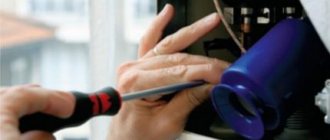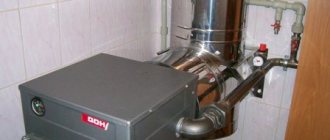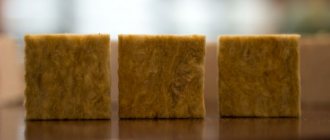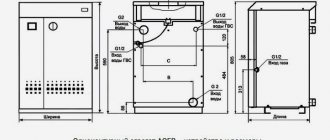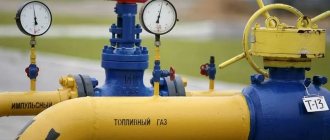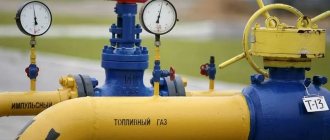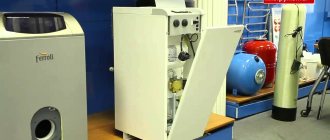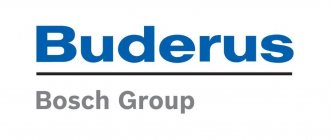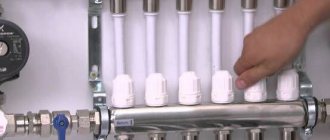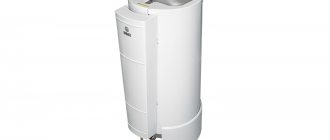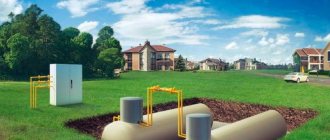The efficiency (coefficient of performance) of a heating boiler is the ratio of the volume of fuel consumed to the volume of heat generated. The efficiency of even the most efficient modern models of hot water boilers cannot be 100% due to heat loss inside the boiler, insufficient thermal conductivity of metals, or imperfections in the operating principle. In addition, the efficiency of the same gas boiler model also depends on the load: the efficiency indicated in the passport is not real in the entire range of heating output.
In the article we will look at how to correctly calculate efficiency, what it depends on and how to increase the efficiency of an already purchased boiler on your own.
Gross efficiency and net efficiency
Not all the heat generated during fuel combustion is used to heat the coolant; a certain part is spent on the boiler unit’s own needs: turbine, fan or smoke exhauster, circulation pump, operation of automation and electronic display, operation of the electric drive (as you already understand, all types of energy received are used in the calculation , including electricity, if the boiler is volatile).
Taking this into account, it is customary to divide the boiler efficiency by the generated heat ( gross efficiency ) and the released heat ( net efficiency ).
This classification allows us to highlight the degree of technical perfection of the boiler - gross efficiency or efficiency of fuel and electricity consumption - net efficiency.
What formula is used to determine the efficiency of the unit’s boiler?
The efficiency factor (COP) of a boiler unit is defined as the ratio of the useful heat used to produce steam (or hot water) to the available heat (heat entered into the boiler unit).
In practice, not all useful heat generated by the boiler unit is sent to consumers. Part of the heat is spent for its own needs. Depending on this, a distinction is made between the efficiency of the unit based on the heat generated (gross efficiency) and the efficiency of the unit based on the heat supplied to the consumer (net efficiency). The difference between the generated and released heat represents the consumption for the boiler house’s own needs. Not only heat is consumed for own needs, but also electrical energy (for example, to drive a smoke exhauster, fan, feed pumps, fuel supply and dust preparation mechanisms, etc.), therefore, consumption for own needs includes the consumption of all types of energy spent on production of steam or hot water.
The gross efficiency of a boiler unit characterizes the degree of its technical perfection, and the net efficiency characterizes its commercial efficiency.
or according to the reverse balance equation
Figure 4.4 - Dependence of boiler efficiency η k on its load (D/D HOM)100
Net efficiency according to the reverse balance equation is determined as the difference
where q s.n is the relative energy consumption for own needs, %.
The efficiency according to the direct balance equation is used primarily when preparing reports for a separate period (decade, month), and the efficiency according to the reverse balance equation is used when testing boiler units. Determining efficiency by reverse balance is much more accurate, since the errors in measuring heat losses are smaller than in determining fuel consumption, especially when burning solid fuels.
Thus, to improve the efficiency of boiler units, it is not enough to strive to reduce heat losses; It is also necessary to reduce in every possible way the consumption of thermal and electrical energy for our own needs. Therefore, a comparison of the operating efficiency of various boiler units should ultimately be carried out based on their net efficiency.
In general, the efficiency of a boiler unit varies depending on its load. To construct this dependence (Fig. 4.4), it is necessary to subtract from 100% sequentially all losses of the boiler unit ∑q sweat = q y.g + q x.n +q m.n +q but ' which depend on the load.
As can be seen from Fig. 4.4, the efficiency of the boiler unit at a certain load has a maximum value, i.e. Boiler operation at this load is most economical.
Source
How to calculate the efficiency of a heating boiler
Values can be calculated in several ways. In European countries, it is customary to calculate the efficiency of a heating boiler based on the temperature of the exhaust gases (direct balance method), that is, knowing the difference between the ambient temperature and the actual temperature of the gases exiting through the chimney. The formula is quite simple:
ηbr = (Q1/Qir) 100% , where
- ηbr (read “this”) – boiler efficiency “gross”;
- Q1 (MJ/kg) – the amount of heat that was accumulated, i.e. used for heating the house.
- Qir (MJ/kg) – the total amount of heat released during fuel combustion;
For example, if Q1 = 19 MJ/kg, Qir = 22 MJ/kg, then gross efficiency = (19/22)*100 = 86.3%. All measurements are carried out at an already established, standard boiler operating mode.
The direct balance method does not take into account the heat loss of the boiler itself, underburning of fuel, deviations in operation and other features, so a fundamentally different, more accurate calculation method was invented - the “reverse balance method”. The equation used is:
ηbr = 100 – (q2 + q3 + q4 + q5 + q6) , where
- q2 – heat loss with exhaust gases;
- q3 – heat loss due to chemical underburning of combustible gases (applicable to gas boilers);
- q4 – loss of thermal energy with mechanical underburning;
- q5 – heat loss from external cooling (through the heat exchanger and housing);
- q6 – heat loss with physical heat of slag removed from the furnace.
Net efficiency of the heating boiler according to the reverse balance method:
ηnet = ηbr - Qs.n , where
- Qс.н – total consumption of thermal and electrical energy for own needs in % expression.
The actual efficiency will almost always differ from that declared by the manufacturer, since it depends on the correct installation of the boiler and heating system, smoke removal system, quality of power supply, etc. It is measured, accordingly, already on the spot.
What will lead to success?
First of all, this is a skill
. Only personal experience will help you win in the future.
In second place is top-end technology. Experienced gamers do not recommend using stock vehicles, since slow tanks that do not provide effective fire support are too boring
That is why it is important to improve tanks to the top with the help of free experience
An important factor is. Training and retraining are best done using gold.
In every battle, you should have gold shells with you, which are more effective at penetrating opponents. The more often this happens, the better the team's result.
What determines the thermal efficiency of boiler units?
The operating principle of a classic floor-mounted gas atmosphere.
The efficiency of heating boilers is not equal at any power; there is a proportional dependence on the load: an increase in the thermal load (the amount of fuel burned) also increases heat loss through the body or chimney. Likewise, operation at minimum power does not always ensure complete combustion of fuel, which leads to a decrease in efficiency.
For example, the service instructions for gas boilers Protherm Wolf KSO with a power of 12.5 kW and 16.0 kW indicate that when operating at maximum power (12.8 kW and 16.3 kW, respectively), the efficiency is 92.5%, while time when operating with a minimum load (4.5 kW and 5.8 kW) - will decrease and amount to only 78.4%.
This is one of the main reasons why you should take a conscious approach to choosing the power of the boiler unit. The most optimal operation in most models is achieved at a load in the range of 60-90% of maximum power.
Otherwise, the efficiency depends solely on the technological excellence of the model, aimed at reducing the above-described q2-6 (reducing the temperature of exhaust gases, efficient combustion of fuel, modulating burners, thermal insulation, etc.), as well as on the quality of maintenance and operation of the boiler unit. Cleanliness of the coolant, regular cleaning and flushing - all this over time seriously affects the efficiency.
How to choose a room thermostat and save up to 30% per month on heating
conclusions
Despite the abundance of models of modern heating equipment, solid fuel boilers continue to be one of the most effective and affordable types of heating equipment. Compared to electric boilers, which have an efficiency of up to 90%, solid fuel units have a high economic effect. The increase in efficiency on new models has allowed this type of boiler equipment to come closer to electric and gas boilers.
Modern solid fuel devices are capable of not only operating for a long time using affordable natural fuel resources, but also have high performance characteristics.
Values of modern boilers depending on the type of fuel
| Photo | Type of boiler depending on the fuel burned | Average efficiency, % |
| Gas | ||
| — Convection | 87-94 | |
| — Condensation | 104-116* | |
| Solid fuel | ||
| — Wood-burning | 75-87 | |
| — Coal | 80-88 | |
| — Pellet | 80-92 | |
| Liquid fuel | ||
| — On diesel fuel | 86-91 | |
| — On fuel oil | 85-88 | |
| Electric heating elements | 99-99,5 |
*From a physics point of view, efficiency cannot exceed 100%: it is impossible to obtain more thermal energy than is released when burning fuel. However, it all depends on how you count. There are two definitions:
- lower calorific value - the heat obtained during the combustion of fuel, when the combustion products are simply removed through the chimney;
- higher calorific value - heat, including the energy contained in water vapor - one of the products of combustion of flammable gases.
Gas condensing boilers additionally accumulate the thermal energy of condensate formed from gas combustion products and deposited on an additional heat exchanger. Thus, a significant part of the heat does not “fly out into the chimney”, and the temperature of the exhaust gases is almost equal to atmospheric.
Construction of a simple condensing single-circuit gas boiler.
According to current standards, both in Russia and in Europe, the efficiency of heating boilers is calculated based on the lowest specific calorific value, so taking into account the additional heat extracted from the condensate leads to values of more than 100%. When calculated based on the higher calorific value, the efficiency of condensing gas boilers is 96-98%, depending on the model and type of installation: wall-mounted boilers usually have higher efficiency than floor-standing boilers (this applies to all gas boilers).
Also from the table you can see that the average efficiency of solid fuel boilers also differs depending on the fuel used, this is due to the degree of fuel combustion, its heat transfer, combustion temperature and heat loss with physical heat of slag removed from the combustion chamber. Even the same solid fuel boiler can produce different efficiencies when operating on different types of fuel.
Operating rules for boiler devices, compliance with which affects the efficiency value
Any type of heating unit has its own optimal load parameters, which should be as useful as possible from a technological and economic point of view. The operation process of solid fuel boilers is designed in such a way that most of the time the equipment operates in optimal mode. This operation can be ensured by following the rules of operation of heating equipment operating on solid fuel. In this case, you must adhere to and follow the following points:
- it is necessary to observe acceptable modes of blowing and exhaust operation;
- constant control over the intensity of combustion and completeness of fuel combustion;
- control the amount of entrainment and failure;
- assessment of the condition of surfaces heated during fuel combustion;
- regular boiler cleaning.
The listed points are the necessary minimum that must be adhered to during the operation of boiler equipment during the heating season. Compliance with simple and understandable rules will allow you to obtain the efficiency of an autonomous boiler stated in the characteristics and improve the operation of a solid fuel boiler.
We can say that every little thing, every element of the design of a heating device affects the value of the efficiency factor. A properly designed chimney and ventilation system ensure optimal air flow into the combustion chamber, which significantly affects the quality of combustion of the fuel product. Ventilation performance is assessed by the excess air coefficient. An excessive increase in the volume of incoming air leads to excessive fuel consumption. Heat leaves more intensely through the pipe along with combustion products. When the coefficient decreases, the operation of boilers deteriorates significantly, and there is a high probability of oxygen-limited zones appearing in the furnace. In this situation, soot begins to form and accumulate in large quantities in the firebox.
The intensity and quality of combustion in solid fuel boilers require constant monitoring. The combustion chamber must be loaded evenly, avoiding focal fires.
Note: coal or firewood is evenly distributed over the grates or grate. Combustion should occur over the entire surface of the layer. Evenly distributed fuel dries quickly and burns over the entire surface, ensuring complete burnout of the solid components of the fuel mass to volatile combustion products. If you have correctly placed fuel in the firebox, the flame when the boilers are operating will be bright yellow, straw-colored.
During combustion, it is important to prevent failure of the fuel resource, otherwise you will have to face significant mechanical losses (underburning) of fuel. If you do not control the position of the fuel in the firebox, large fragments of coal or firewood falling into the ash box can lead to unauthorized combustion of the remaining fuel mass products.
Soot and resin accumulated on the surface of the heat exchanger reduce the degree of heating of the heat exchanger. As a result of all of the above violations of operating conditions, the useful volume of thermal energy required for the normal operation of the heating system decreases. As a result, we can talk about a sharp decrease in the efficiency of heating boilers.
How to increase the efficiency of a gas boiler
It is almost impossible to increase the efficiency of fuel combustion by interfering with the technical structure of the boiler; it will not be possible to install the same layer of thermal insulation due to the banal failure of the manufacturer to provide a place for it. In addition, doing this yourself is prohibited. Nevertheless, there are ways to increase the efficiency of a gas boiler, especially if it is an imperfect old-style model:
- Ready-made economizer for chimney – replaces a certain section of the chimney and is designed to accumulate heat from gases exhausted through the chimney (some kind of imitation of condensing boilers). However, it is necessary to accurately calculate the parameters of the economizer and the requirements for the chimney in order to maintain the necessary draft and prevent reverse draft, for example, in strong winds. The issue price is 1,700-2,500 rubles.
Sandwich mesh economizer for chimney pipe. - A homemade economizer is almost identical to the finished products described above. We have already described how to make an effective economizer in one of the previous articles.
- Cleaning the boiler and flushing the heat exchanger are regular maintenance measures that are meaningless for new boiler units, but extremely effective for those that have been in use for at least several seasons. The fact is that during operation, scale and other salt deposits form inside the heat exchanger, and the external fins of the heat exchanger, burners and igniter become clogged. All this leads to an increase in gas consumption, a decrease in heating output, and, accordingly, a decrease in efficiency (often up to 20-30%). We have also already discussed how and how often it is necessary to clean a gas boiler.
- Gas filter - it is installed in front of the shut-off valve of the gas main and is designed to clean the gas from debris and impurities that are sometimes found in the composition. This not only helps reduce soot formation, but also, by improving the quality of the fuel, slightly reduces heat loss during underburning.
The remaining methods involve proper commissioning, which is carried out once, when the boiler is first started, exclusively by specialists. With correct initial settings, the efficiency guaranteed by the manufacturer is ensured. It is important to understand that it is impossible to increase this indicator by interfering with the technical structure of the boiler itself, and even more so, it is not safe.
Instructions BoilersEnergy-saving technologies
Cast iron and steel structures - what are the differences?
Whatever material the boiler is made of, it is very important that it meets the basic operational characteristics. Let's look at them in more detail
First of all, you should pay attention to the material of the heat exchanger - cast iron or steel. If you want to use a ready-made solid fuel boiler circuit, it’s unlikely that you’ll be able to make a cast iron heat exchanger yourself
Such work requires both special equipment and special knowledge and skills. Therefore, you can purchase ready-made sectional structures, which are disassembled before transportation and reassembled on site.
Cast iron heat exchangers tend to become covered with dry rust - a special film that protects the walls of the unit from destruction. In addition, wet rust also forms much more slowly, which is due to the long service life of cast iron products - from 10 to 25 years. Other advantages of cast iron heat exchangers include the absence of the need for frequent and complex maintenance. Cleaning of such devices is rarely required, and carbon deposits practically do not reduce the efficiency of the boiler. If it is necessary to repair or increase the power of the unit, you only need to replace the defective sections or increase their number.
The disadvantages of cast iron products are:
- the large mass of the boiler requires a separate foundation;
- difficulties in the assembly process and high transportation costs;
- sensitivity to thermal shock - cast iron does not like temperature changes, so contact of a hot surface with cold firewood or cold water can be detrimental to it;
- high thermal inertia - it takes a long time to warm up the boiler, but its subsequent cooling occurs slowly.
As for steel products, they are less sensitive to temperature changes and are not afraid of contact with cold objects. This property allows, when assembling solid fuel heating boilers according to drawings, to equip them with sensitive automatic elements. And thanks to their low inertia, such units quickly warm up and cool down - this allows you to regulate the air temperature in the house. At the same time, you can make a drawing of a long-burning solid fuel boiler with your own hands, which will allow you to take into account all the nuances.
In appearance, steel boilers are solid welded units that are quite difficult to transport, although their sensitivity to mechanical damage is much lower than their cast iron counterparts.
The possibility of repairing steel boilers is, from the point of view of some experts, very doubtful. Repairing, as well as welding a boiler with your own hands according to a drawing at home, is quite difficult; over time, leaks may form at the seams in it. In fairness, we note that everything depends on the worker’s skills in working with a welding machine. But repairing a cast iron heat exchanger is still easier - you only need to replace the sections.
As a rule, boilers with cast iron heat exchangers are non-volatile and inexpensive, so they can be a worthy alternative to already installed heating equipment in the event of a power outage. Coolant circulation in such units occurs naturally, without the use of a pump. However, the batteries must be installed in such a way that when heated, water moves freely through the pipes under the influence of pressure in the boiler.
Heat loss when removing flammable gases
The most significant heat losses occur as a result of the evacuation of flammable gases into the chimney (q2). The efficiency of the boiler largely depends on the combustion temperature of the fuel. The optimal temperature pressure at the cold end of the water heater is achieved when heated to 70-110 ℃.
When the temperature of the exhaust combustible gases drops by 12-15 ℃, the efficiency of the water heating boiler increases by 1%. However, in order to reduce the temperature of the exhaust combustion products, it is necessary to increase the size of the heated surfaces, and, therefore, the entire structure as a whole. In addition, as carbon monoxide cools, the risk of low-temperature corrosion increases.
Among other things, the temperature of carbon monoxide also depends on the quality and type of fuel, as well as the heating of the air entering the firebox. The temperatures of incoming air and exiting combustion products depend on the type of fuel.
To calculate the heat loss rate with flue gases, use the following formula:
Q2= (T1-T3) × (A2 ÷ (21-O2) + B), where
T1 – temperature of evacuated flammable gases at a point downstream of the superheater;
T3 – temperature of air entering the furnace;
21 – oxygen concentration in the air;
O2 is the amount of oxygen in the exhaust combustion products at the control point;
A2 and B are coefficients from a special table that depend on the type of fuel.
